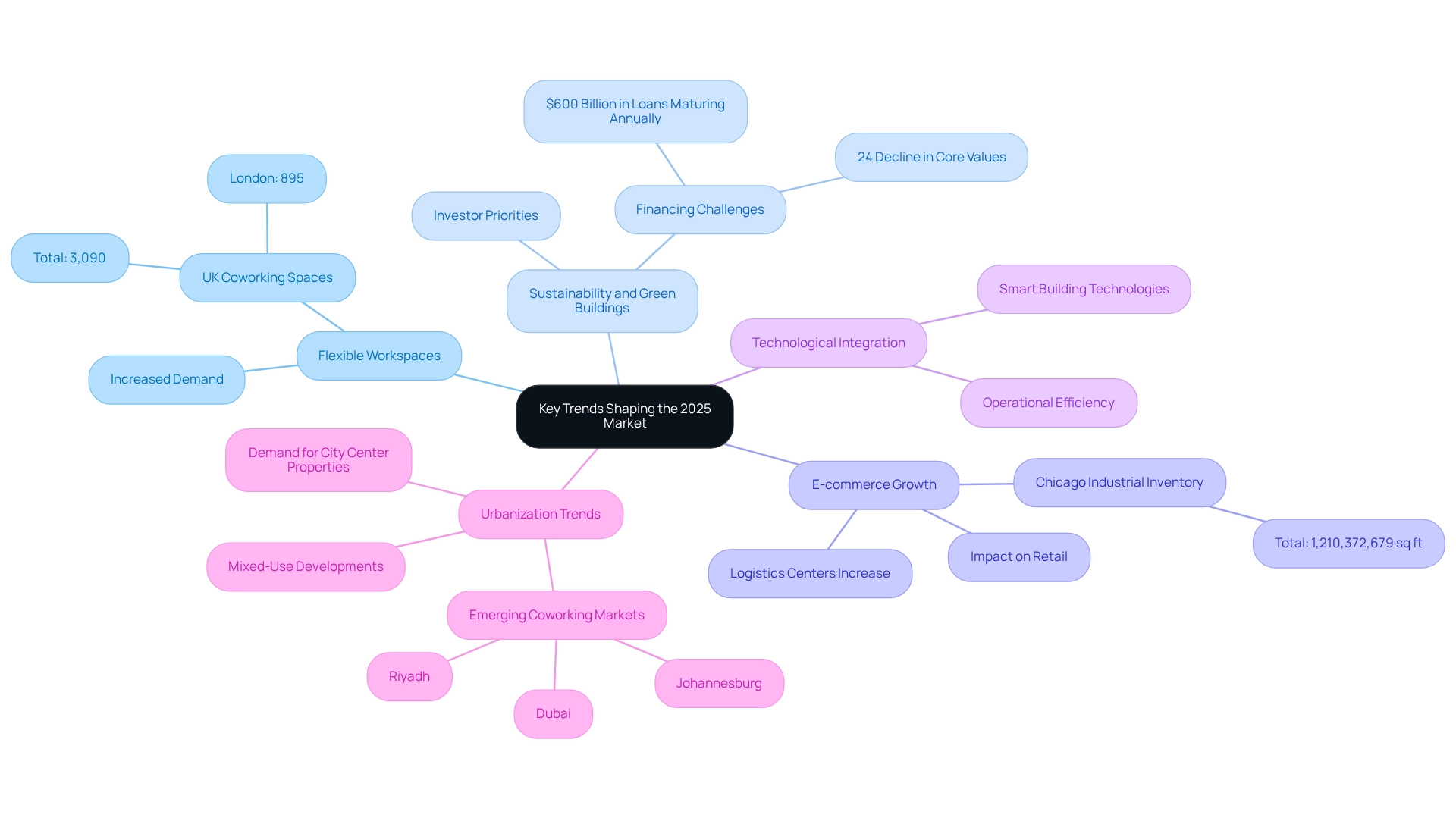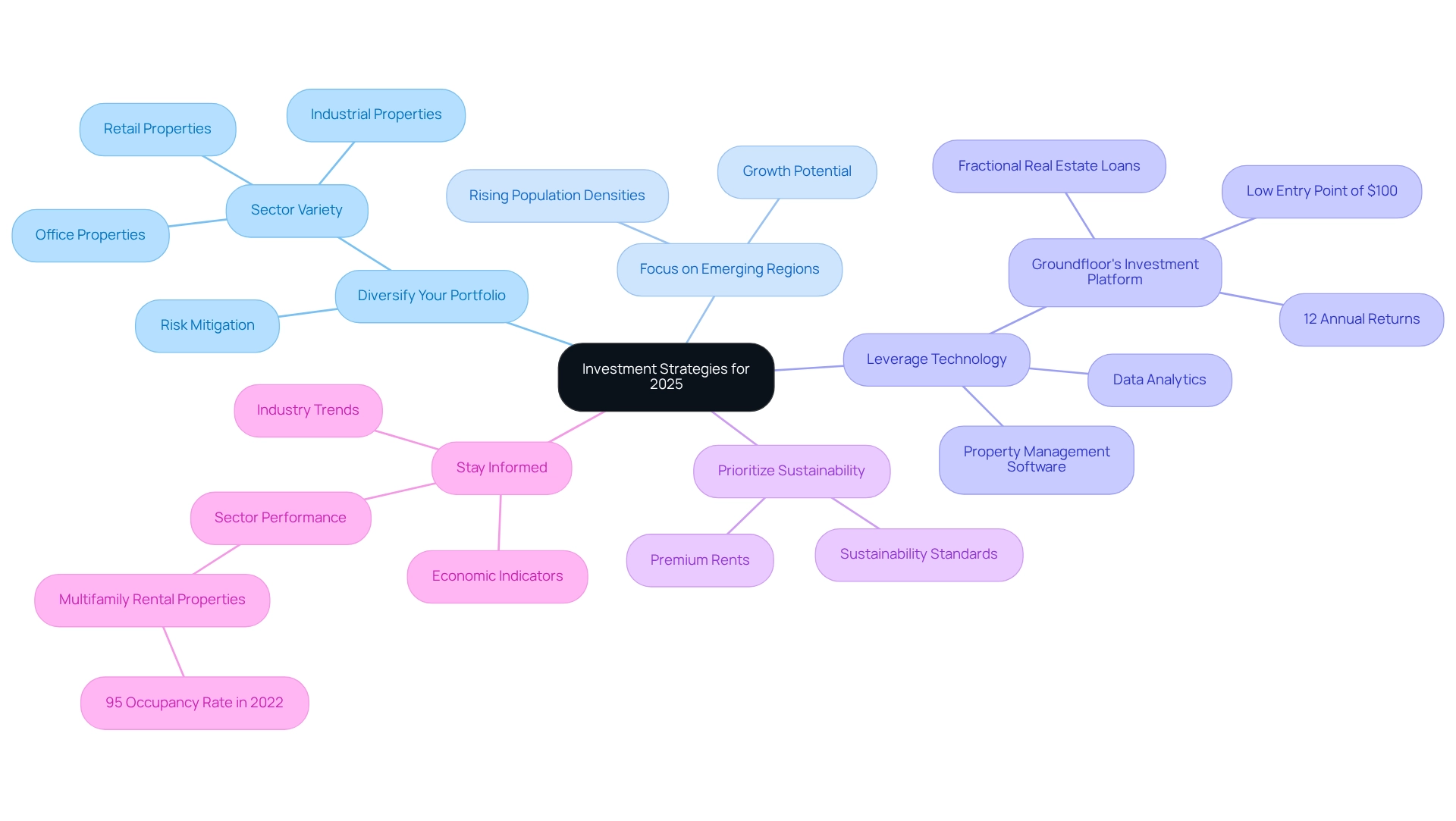Overview
The commercial real estate outlook for 2025 presents significant trends that demand attention:
- An increased demand for flexible workspaces
- A heightened focus on sustainability
- The transformative impact of e-commerce on retail properties
These insights are underpinned by a thorough analysis of economic indicators, vacancy rates, and emerging investment strategies. By examining these factors, we can clearly see how they will shape the market landscape and guide investor decisions in the years to come.
As we delve deeper, the data illustrates a compelling narrative. For instance, the shift towards flexible workspaces indicates a changing workforce dynamic, prompting businesses to rethink their real estate needs. Sustainability is no longer just a buzzword; it is becoming a critical factor in property valuation and investment decisions. Additionally, the rise of e-commerce continues to redefine retail spaces, creating both challenges and opportunities for investors.
In conclusion, these trends not only highlight the evolving nature of commercial real estate but also emphasize the necessity for investors to adapt their strategies accordingly. Understanding these key insights will empower investors to make informed decisions that align with market demands and future growth potential.
Introduction
Navigating the complexities of the commercial real estate market demands a keen understanding of the various factors that influence its dynamics. As we approach 2025, investors and stakeholders must analyze:
- Economic indicators
- Vacancy rates
- Rental trends
to fully grasp the current landscape. The rise of flexible workspaces, sustainability initiatives, and the impact of e-commerce are reshaping traditional paradigms, prompting a significant shift in investment strategies. By embracing technological advancements and staying informed about emerging trends, investors position themselves to capitalize on opportunities and mitigate risks in this ever-evolving sector.
Analyze the Current State of Commercial Real Estate
To effectively analyze the current state of commercial real estate, one must adopt a structured approach that highlights key market insights:
-
Review Economic Indicators: Key metrics such as GDP growth, employment rates, and consumer spending are critical, as they directly influence demand for business properties. For instance, a projected GDP growth of 2.5% in 2025 is expected to bolster demand across various sectors.
-
Evaluate Vacancy Rates: Understanding current vacancy rates is vital for assessing supply and demand dynamics. The retail sector, for example, boasts the lowest vacancy rate at 4.1%, despite facing challenges with malls, which have an 8.6% vacancy rate. This indicates a resilient retail market overall, driven by limited supply and strong demand. Additionally, the retail sector has shown adaptability, achieving 3.2% growth despite a 12% decline in foot traffic year-over-year, highlighting its resilience.
-
Assess Rental Trends: Analyzing rental price trends over the past year reveals areas of growth or decline. Multifamily rental properties, for instance, maintained an impressive occupancy rate of approximately 95% in 2022, reflecting sustained demand in this segment.
-
Study Financing Conditions: Investigating current interest rates and lending practices is crucial, as these factors significantly impact investment viability and property acquisition. Higher interest rates can complicate transactions and refinancing, potentially leading to lower property valuations. As a result, higher interest rates often make transactions and refinancing less feasible, which can lead to lower property valuations.
-
Monitor Legislative Changes: Staying updated on new regulations or policies, such as zoning laws or tax incentives, is essential for understanding their potential impact on business properties. Emerging sectors like data centers and sustainable buildings are gaining traction, indicating a shift in property utilization that may be influenced by legislative support.
-
Consider Industrial Inventory: The total industrial inventory in Chicago, which amounts to 1,210,372,679 square feet, offers valuable context regarding the scale of the industrial sector in business property. This statistic can improve the examination of supply and demand dynamics within the industrial sector, and by incorporating the commercial real estate outlook 2025, including the performance of emerging sectors and the substantial industrial inventory, investors can develop a thorough understanding of the business property landscape. This knowledge enables informed strategic planning and decision-making.

Identify Key Trends Shaping the 2025 Market
Key trends shaping the commercial real estate outlook 2025 are pivotal for investors looking to navigate this dynamic landscape.
-
Increased Demand for Flexible Workspaces: The shift towards remote work has significantly boosted the demand for flexible office spaces. Landlords are adapting their offerings to meet this evolving preference, ensuring competitiveness in a shifting environment. Notably, the UK boasts 3,090 coworking spaces, with London leading at 895 locations, underscoring the growing trend of flexible workspaces.
-
Sustainability and Green Buildings: Investors are increasingly prioritizing sustainability, actively seeking properties that adhere to green building standards. This trend reflects a broader commitment to environmental responsibility and is poised to influence future investment decisions. Moreover, the business real estate market faces considerable financing challenges, with approximately $600 billion in loans expiring annually until 2028, coinciding with declining valuations.
-
E-commerce Growth Impacting Retail: The ongoing expansion of e-commerce is reshaping the retail landscape. Traditional storefronts are on the decline, while logistics and distribution centers are witnessing a notable increase to support online shopping demands. For instance, the total industrial inventory in Chicago stands at 1,210,372,679 square feet, highlighting the scale of this shift.
-
Technological Integration: The incorporation of smart building technologies is becoming a standard expectation in business properties. These advancements not only enhance operational efficiency but also improve tenant experiences, making properties more attractive to potential occupants.
-
Urbanization Trends: As urban areas continue to attract more inhabitants, the demand for business properties in city centers is expected to rise. This trend is particularly evident in mixed-use developments that cater to urban dwellers' needs. Emerging coworking sectors in the Middle East and Africa, with cities like Dubai, Riyadh, and Johannesburg at the forefront, further illustrate the global nature of this trend, highlighting the importance of the commercial real estate outlook 2025. By staying informed about these trends, investors can strategically position themselves to seize new opportunities within the business property sector.

Develop Investment Strategies for 2025
To cultivate effective investment strategies for 2025, consider the following approaches:
-
Diversify Your Portfolio: Spread investments across various sectors, including office, retail, and industrial properties, to mitigate risks associated with economic fluctuations. This strategy is essential since the commercial property sector is responsive to wider economic changes. A Realtor noted, "The sector remains responsive to wider economic changes, and stakeholders must cautiously navigate these to seize emerging opportunities and reduce potential risks."
-
Focus on Emerging Regions: Target areas exhibiting growth potential, particularly those with rising population densities or active economic development initiatives. These areas are likely to yield higher returns as demand increases.
-
Leverage Technology: Employ data analytics and advanced property management software to enhance decision-making processes and operational efficiency. For instance, Groundfloor offers a unique investment platform that allows both accredited and non-accredited investors to participate in real estate loans on a fractional basis, democratizing access to real estate investment opportunities. This technological integration can provide a competitive edge in identifying lucrative opportunities.
-
Prioritize Sustainability: Invest in properties that adhere to sustainability standards, as these are increasingly favored by tenants and can command premium rents. The retail sector, for example, has experienced a 3.2% growth due to challenging economic conditions, emphasizing the significance of strategic investments.
-
Stay Informed: Continuously update your understanding of industry trends and economic indicators to adapt your strategies accordingly. For example, multifamily rental properties achieved an impressive occupancy rate of approximately 95% in 2022, underscoring the importance of staying attuned to sector performance.
By implementing these strategies, investors can effectively navigate the commercial real estate landscape and improve their prospects according to the commercial real estate outlook 2025, particularly in light of the macroeconomic factors influencing the market.

Conclusion
Understanding the current landscape of commercial real estate is essential for investors aiming to thrive in 2025. Economic indicators, vacancy rates, rental trends, financing conditions, legislative changes, and industrial inventory form a comprehensive framework for analysis. As the market evolves, recognizing these factors enables stakeholders to make informed decisions and strategically position themselves to capitalize on emerging opportunities.
The trends shaping the commercial real estate market—such as the rise of flexible workspaces, a strong emphasis on sustainability, the impact of e-commerce on retail, technological advancements, and urbanization—underscore the shifting dynamics of the sector. By staying attuned to these trends, investors can adapt their strategies and effectively navigate the complexities of the market.
Ultimately, developing robust investment strategies that encompass:
- Diversification
- A focus on emerging markets
- Leveraging technology
- Prioritizing sustainability
- Maintaining awareness
will empower investors to succeed in this rapidly changing environment. With a proactive approach and a keen eye on both current trends and future developments, stakeholders can mitigate risks and seize the opportunities that the commercial real estate market will undoubtedly present in the coming years.




